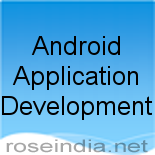Android Application Development
Android is the newest big-ticket entrant in the crowded mobile OS market, developed by Google and 30 other companies under the Open Handset Alliance (OHA). Android's unique feature is that it is an open source platform and Android-based apps can be freely distributed directly to the users instead of through a Google-only route.
Developers looking to develop great apps for the Android OS need to first download the Android SDK from Google's site and get started. Android application development is unique because Android is licensed under the Apache license that requires you to open source your portion of the code even while distributing, sharing or using the software for commercial purposes.
All Android apps are run on the Dalvik virtual machines that are optimised for parallel virtual machines execution on low memory systems. Setting up your Android Development Environment is a fairly straightforward process. First of all download the powerful Android SDK from the Google site. Next, download the free Eclipse IDE required for Java based programming on the Android. Finally, install the Android plugin and you are all set to develop great Android apps and programs.
The Android software application development versatility can be seen from the fact that you can create high quality Android apps using the same tools used for great Java application development. If you need a resourceful library for developing rich mobile applications you need no further than the exhaustive Android core libraries.
What's more the great Android dev tools simplify testing, running and debugging your Android apps a child's play, literally. What you need to know before starting your custom Android Development process is that you need to install the Android Development Tools (ADT) plugin only if you plan to use the Eclipse IDE as your development environment. If not then no need to install the ADT plugin. Simple, isn't it.
Android vs iPhone SDK:
Although this is a pretty difficult comparison to make given the fact that both the SDK's have something good going for them. While the Android SDK is available for use on any machine the iPhone SDK can only be used on Mac OS machines and that too, recent ones. Apple also requires you to sign a 10-page long restrictive agreement on developing and distributing the iPhone apps whereas Google has not put any such restrictions on the use of its Android SDK. Just download it and get started. The Apple iPhone SDK comes with their proprietary Xcode, Interface Builder and Instruments tools. The flip side is that if you aren't familiar with it you have to undergo a fairly steep learning curve. There are no such hassles with the Android SDK as the standard development environment used is the Eclipse IDE, which is kind of the industry standard for any platform except the Mac OS X and Windows. Also the Android SDK is more developer friendly and open source as compared to any other mobile OS development platform out there.



